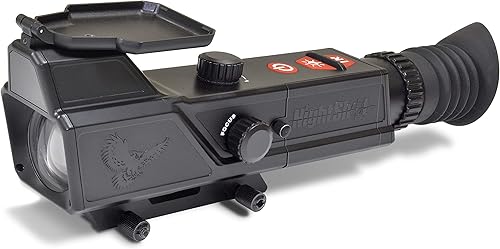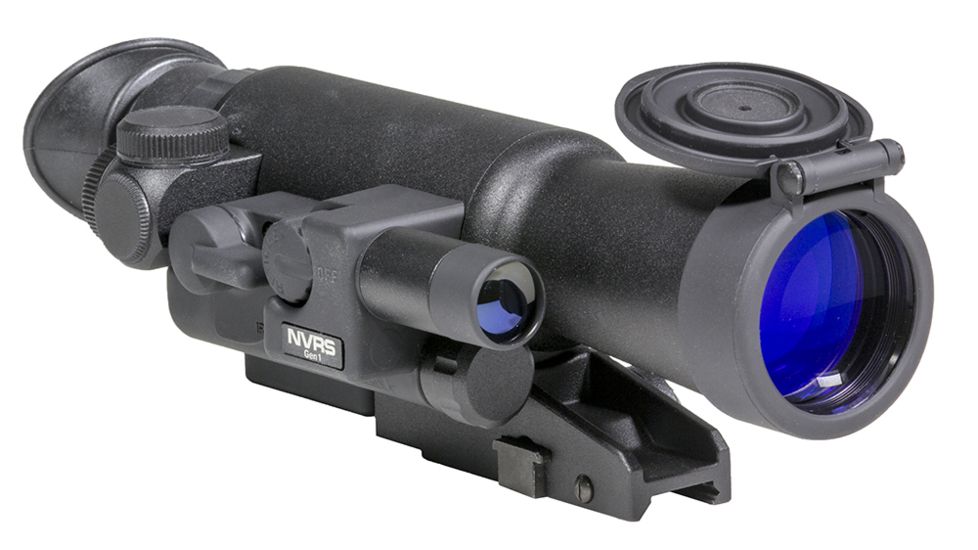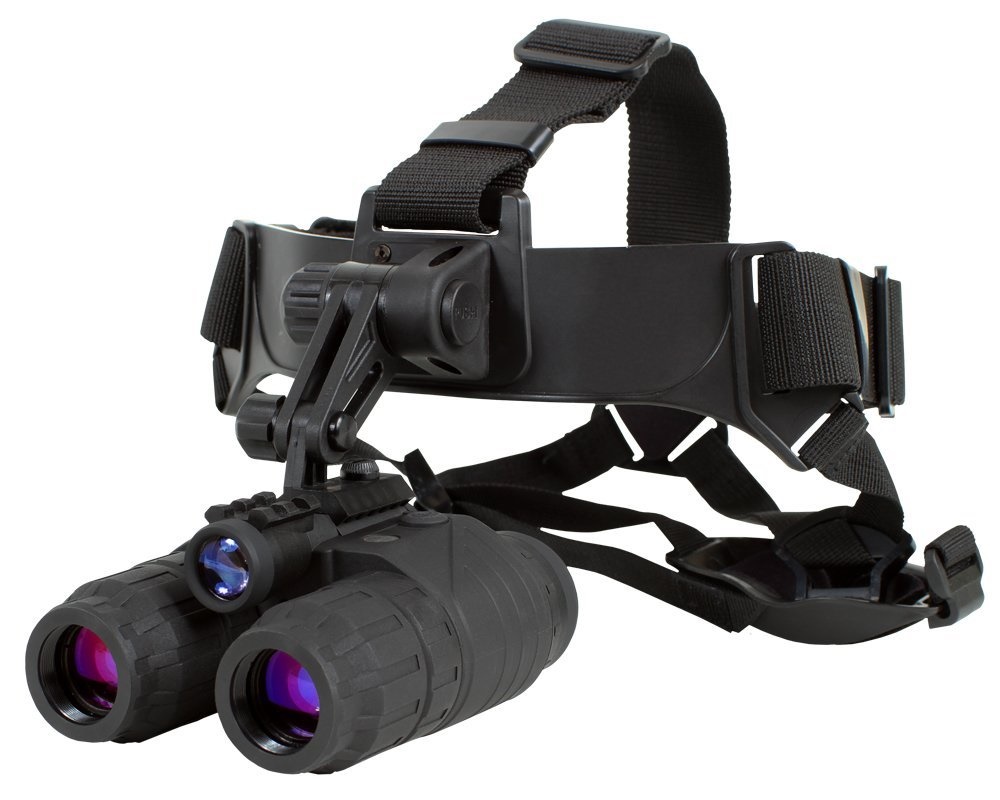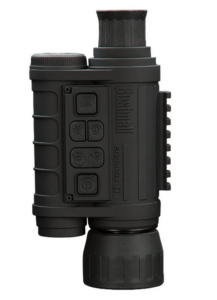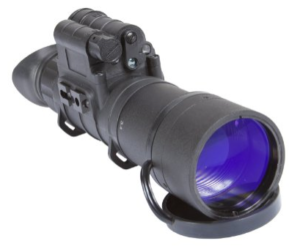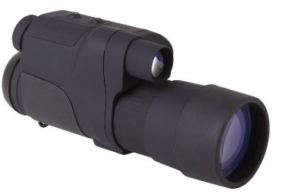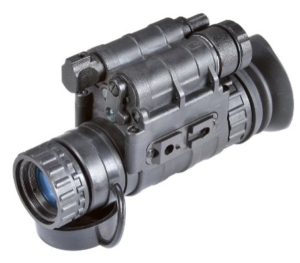Night vision rifle scopes prove to be very useful for multiple groups of people; hunters can attest to the importance of owning this type of scope when hunting animals like hogs and raccoons in the dark. The military relies on this form of optic technology extensively in low light conditions. If you hunt or hold target practices at night, a night vision riflescope is essential for locating your target and optimizing accuracy.
This guide covers everything you need to know to make an informed purchase of a night vision rifle scope. We’ll cover options in various price ranges and with varying technology, as well as go over what the different brands and generations of technology have to offer.
Best Night Vision Rifle Scope for the Money Under $500
Sightmark Wraith HD Digital Riflescope
This Sightmark Wraith HD 4-32×50 is good for an AR-15. It comes at a lower to medium price point as well, so it is affordable. This scope can be used for both day and night modes. It features high definition sensors, high-resolution imaging, and recording capabilities.
It has a 1920 x 1080 HD sensor for full-color clarity while in the daylight. You can then switch the scope to night mode and choose from green, black, and white viewing options. You can use this riflescope with up to ten reticle options, and the night illuminator of the scope can detect up to 200 yards.
You will also find 8x digital zoom and a 2x optical system for up to 16x magnification. With its five weapon profiles, you can save zeroes for different firearms and calibers.
With this purchase, you will receive an IR flashlight, objective lens cover, fixed Picatinny mount, and user manual. The included IR flashlight is a powerful 850 nm and is removable. It grants you up to an additional 200 yards of night detection.
The weaver rail of this night vision scope allows you to purchase and add additional accessories. The micro USB and memory card slots allow for photo and video export and an additional outboard power supply.
The removable eye cup can help stop light dispersion during the night and can be removed easily during the day to allow for easier viewing in better lighting conditions.
Night Owl Optics NightShot Digital Night Vision Riflescope
If you need a night vision scope to hunt vermin at night, this is definitely the pick to consider. It is another affordable night vision rifle scope you can find for under $500. It is great for recreational shooting and comes with more advanced features that allow you to also use it in nighttime shooting scenarios.
It is an easy to use scope. Simply mount, sight, and shoot. If you need advice on the proper mounting of this scope, you should consult with the manufacturer or call 800-444-5994 for more information. It is weaver or Picatinny rail compatible. They are the same .835 dimension. If you instead have a dovetail rail, you will need an adapter rail to convert it from dovetail.
This scope has a range of between 100 and 200 yards in a typical nighttime environment and has a high-resolution, 640×480 display. You can use this scope with rifles up to 30 calibers. The objective lens offers 3x magnification, a focal length of 52mm, and a field of view of 5.6-degrees. The aperture is 40mm, and the focusing distance is 3m to infinity.
You can purchase an optional high power IR illuminator separately if you wish. You can choose between three different reticle types with this night vision rifle scope. Each of these types can then be configured in black or white, allowing you to adjust the type and color based on your current shooting environment.
The scope uses 4 AA or lithium batteries and can run for four hours with IR on high or seven hours with IR on low. The scope is constructed with a thermoplastic material and has a built-in infrared illuminator. Using this scope during the day will not damage it.
Firefield 3×42 Gen 1 Night Vision Riflescope
If you are looking for a more budget-friendly option, consider the Firefield 3×42 Gen 1 night vision scope. It comes in at under $500 and is great for entry-level night vision optics. You can use it for nighttime activities, including hog hunting, coyote hunting, or any other nighttime shooting excursions.
This night vision scope is designed specifically for an AR-15 and other similar and more modern sporting rifles. It is incredibly lightweight, durable, and has an easy to use mounting system. You can quickly and easily swap out your optics for either daytime or nighttime.
The scope also features high-quality, multi-coated glass and a built-in infrared illuminator. It has an illuminated duplex reticle with brightness adjustments.
The titanium body of this night vision scope comes with an IPX4 water-resistant rating, so it is great for all your rugged outdoor adventures. However, keep in mind that its range is only around 75 yards, so you will need to get closer to your targets.
Budget Pick – Under $200
BESTSIGHT Night Vision Scope
The BESTSIGHT night vision scope is not simply a scope; rather, it is a system that you can use with your rifle scope as a night sighting system. There are separate parts that, when combined, create a complete system you can attach to your scope.
It includes a unit that slips over the viewing end of the scope, a unit attached to the main tube that serves as the illumination system, and a camera style viewing screen, which is what the scope sees through and displays on the primary optical system, or the main scope, with the 5-inch clear display screen.
Even if you find yourself immersed in complete darkness, you can achieve a high-quality visual experience. The best working distance for the infrared illuminator of this model is around 100 yards. Beyond this distance, you will see dots and lines begin to appear on the night mode screen. If you need to achieve greater clarity and see further distances, you want to purchase a higher-power infrared illuminator.
This model does not say anything about generational levels, so we can’t testify to the state of the generated light gathering ability of this particular scope. However, you will find a bargain with this system, and it works great as a recreational sight compared to a professional-grade optical system.
Higher Price Tag Options – Under $1800
ATN Night Spirit-2 Gen 2+ Night Vision Multi-Purpose System
This is another multi-purpose night vision system. The ATN Night Spirit-2 Gen 2+ is also waterproof and has a built-in infrared illuminator to be used while in total darkness. The multi-coated optics and 2nd generation intensifier tube allow for maximum light gathering.
It has a 3x magnification, pro-shield lens coating, and a field of view of 18 degrees. It is easy to use with its single switch knob operation, and it also features automatic brightness control and a bright light cut-off.
This unit is compact, durable, and rugged and can be handheld or head-mounted to allow for hands-free use. It offers high resolution for clear and bright images in low light conditions and total darkness. It has all-glass optics coated to absorb light.
Pulsar Phantom 4×60 MD WPT Night Vision Riflescope
This Generation 3 Pulsar Phantom Night Vision Riflescope is good for medium to long distances while allowing for a clear view of your target in 57-64 Ip per mm resolution. It comes with a 60mm lens and a 1.69 Relative Aperture for more efficiency. It also comes equipped with a powerful IR illuminator to enhance visibility at night. It works well in the darkest shooting environments and still allows for precision placement.
For brightness control, you can use the green on green and red on green feature. It also has a long battery life and low battery indication, so you are never stuck in the dark. It is built from a durable and made to last composite material and aluminum D16. The scope is rainproof and dustproof, with an IPX6 weather rating.
For comfort, it offers 50mm eye relief. It is both reliable and efficient. The internal focusing knob allows for easy operation of this night vision scope. It features a military-style design and can be used virtually everywhere and in all types of environments.
The IR illuminator has a high light gain and allows you to see clearly in critically low light situations. The fast start-up function also allows you to make quick assessments. This scope also comes with a Pulsar Phantom remote control with three buttons: On/Off, IR illuminator, and quick start-up.
The Pulsar Phantom Night Vision scope is on the higher end of the price spectrum, so you will also want to consider this when narrowing down your purchase options as well.
More Information – Top Night Scope Brands
There are many great brands out there that produce quality night vision scopes. Most likely, if you’re reading this article, you’re either a novice, or you’re an expert who is seeking the “best of the best” scope for a bargain price.
Below, we have detailed more information regarding the night vision scopes brands that we outlined at the beginning of the article. This information may help you decide which scope to purchase above, especially since they all come with a variety of enticing features and capabilities.
Armasight
Armasight is a big name in the thermal imaging and night vision technological field; they’ve designed and invented products like night vision scopes for years. Their main headquarters is located in San Francisco, California, and they offer spectacular quality for a wide range of prices.
You can purchase a high standard night vision scope for $10,000.00 or purchase a scope for as low as $150.00. It merely depends on the features and technology you desire and the amount of money you’re willing to spend.
ATN
ATN is another brand that specializes in night vision and thermal imaging scope technology. “ATN” is an acronym for American Technologies Network, and like Armasight, it is also located in San Francisco. This company has been around for over two decades. It takes great pride in having all of its products manufactured in the United States, producing scopes that are expensive and relatively inexpensive. Both ATN and Armasight are used frequently by hunters, law enforcement employees, and the military.
Firefield
Firefield is a night scope brand established in 2009 and is rapidly building its reputation among the shooter community. Firefield saw the growing need for affordable scopes and thermal imaging products with the decline in the economy; they realized that there was an opportunity to serve people who couldn’t afford over-priced tactical products, so their philosophy is to provide optical equipment for shooters that are of high quality but low price. Never let the newness of a company deter you from giving their quality of products a try!
Sightmark
Emerging in 2007, Sightmark is also a new brand and company increasing in popularity among the shooting community. According to their slogan, Sighmark’s technology equips users with the ability to “make the mark.” With their main headquarters in Mansfield, Texas, the brand and products have found their way into many outdoors retailers such as Academy Sports and Cabela’s, and Gander Mountain. Sightmark offers high-quality riflescopes for affordable prices. It’s no wonder that Sightmark a rapidly growing brand.
Yukon
Yukon is another great rifle scope company. They’re committed to giving their consumers the latest and greatest in night vision rifle scope technology. Most people that have never shot a rifle in their life have heard of this brand and name, which speaks to the popularity of this brand. It’s a name to consider when shopping for the perfect night vision riflescope for you.
Night Vision Generations
If you’re new to the shooter community and learning about what rifle scope is best to purchase, it is not only important to compile information about all of the best brands to purchase from, but also to know the difference between Generation 1, Generation 2, and Generation 3 scopes. These terminologies are typically shortened to Gen 1, Gen 2, and Gen 3, so keep this in mind as you start searching and shopping for the best scope.
Gen 1
Gen 1 is fairly simplistic and affordable. For most shooters and hunters, it offers everything that you need and then some while also being the most inexpensive of all the generations. Gen 1 was introduced during the early sixties when the Space Age developed new technologies that humanity never thought was possible.
A Gen 1 night vision scope is sufficient for most shooters’ needs; however, since it is the first generation, it has fewer perks and may operate more slowly than the later generations.
Gen 1 scopes typically have the following capabilities and shortcomings:
- The average useful sight range for Gen 1 is about 75 yards
- It has a shorter battery lifespan than Gen 2 and Gen 3 scopes
- Overall life expectancy is 1500 hours of use
- Due to older technology, the user is generally illuminated, thus making them obvious and visible
- Lower resolution imagery
Gen 2
Gen 2 is a step up from Gen 1. Although it is more expensive than the Gen 1, it’s still not as expensive as the Gen 3. However, in the form of technological advances, Gen 2 blows Gen 1 scopes out of the water.
Here are some of the details regarding a Gen 2 scope:
- The average useful sight range is about 200 yards. (That’s 125 more yards than Gen 1’s 75 yards)
- It has a longer battery life than Gen 1
- Overall life expectancy is 4500 hours
- Great resolution for images
- Doesn’t need the IR illumination
Gen 3
Gen 3 is the big, bad boy when it comes to night vision rifle scopes. It’s so advanced that the United States Military uses the Gen 3 on all of their rifle scopes and other optical equipment. However, keep in mind that most Gen 3 riflescopes are very pricey.
Don’t fret, though; with its advanced technology and accuracy, you will get what you pay for!
Here are some details regarding a Gen 3 scope:
- The average useful sight range is 300 yards. (Sometimes more depending on the model and grade that you have)
- Offers the best low light performance
- Imagery technology allows it to work in all light shades and conditions
- The absolute best resolution for images
- Has the longest life expectancy with an amazing 10,000 hours and more of operation!
Night Vision Scope FAQ
Still have questions about the best night vision rifle scopes of 2021? Read through our brief FAQ below for the answers to some of the more commonly asked questions.
Can you use a night vision scope during the day?
It really depends on the technology the scope uses. You can use a digital scope during the day, and it will still work great and offer amazing resolution. However, you can’t use a traditional night vision scope during the day because they may become damaged by the sunlight. No matter what, follow the manufacturer’s instructions and recommendations regarding your specific night vision scope.
What should I look for when purchasing the best night vision scopes?
First, you need to decide on the kind of technology you want. You can find more traditional night vision scopes that are more affordable but may not do everything you want them to do. Next, consider the magnification. Most night vision scopes have a very moderate level of magnification. Typically, you will find that 3x or 4x magnification is enough.
Do I need anything extra?
If you have a digital scope, then it will likely require an IR booster or light. If the scope doesn’t already come with one, then this will be an additional cost to consider. Some people also like to record what they are seeing through their scope and transmit it through Wi-Fi.
How long does a night scope typically last?
Digital night scopes do not burn out as fast as a traditional scope. As long as you follow through with proper care, they can last a lifetime. A Gen 1 scope can vary depending on its quality but can usually see up to 1000 hours of use. Budget models may only see hundreds of hours.
Conclusion
After reviewing the product options listed, as well as the additional information provided regarding different brands and scope generations, you have found the best night vision scope to suit your needs.


